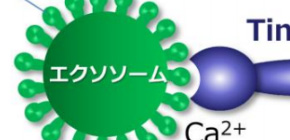
Successful development of exosome purification method
Will create innovation in early diagnosis of cancers and other diseases and assessment of therapeutic efficacy of drugs
Exosomes, cell-derived extracellular vesicles (EVs) sized 30-100 nm in diameter, act as media for carrying lipids, proteins, and RNAs derived from their producing cells between producing cells and target cells. In recent years, it has been reported that components of exosomes, especially proteins and RNA, are useful as biomarkers of pathological cells such as cancer cells, and researchers are actively studying the possibilities of whether exosomes can be used for early diagnosis of diseases, therapeutic efficacy of diseases, and prediction of prognosis.
Exosomes are enriched in mRNAs and non-coding RNAs derived from their producing cells. Even a small amount of these samples can be amplified by a polymerase chain reaction (PCR), so their possibilities as epoch-making biomarkers of diseases are being investigated. Currently, an ultracentrifugal method and polyethylene glycol (PEG) precipitation method are used for purifying exosomes, but exosomes obtained by these methods contain many impurities, so the reliability of exosomes as biomarkers is in question.
A group of researchers led by Visiting Professor HANAYAMA Rikinari and Specially Appointed Researcher NAKAI Wataru at the Immunology Frontier Research Center, Osaka University, and a research group from Wako Pure Chemical Industries, Ltd., succeeded in developing a novel method for EV purification that is easy and reproducible. (Dr. Hanayama is a professor at the Department of Immunology, Graduate School of Medicine, Kanazawa University.)
Tim4, a membrane protein, is an exosome-specific receptor in target cells. Cells in which Tim4 is expressed bind to phospholipid posphatidylserine (PS) present on the surface of the exosome membrane via an IgV-like domain outside of the Tim4 extracellular region in a Ca 2+ -dependent way, thereby taking exosomes into cells. So, this group created “Tim4 magnetic beads,” which bind the extracellular region of Tim4 to magnetic beads.
Tim4 binds to PS on the surface of the exosome membrane in a Ca 2+ -dependent way, so this group released them by an elution buffer containing the chelating agent EDTA, efficiently purifying the exosome. As a result, it has become possible to identify proteins and RNAs on exosomes which were previously unidentified. It is expected that this will bring about innovation for early diagnosis of diseases including cancer as well as assessment of therapeutic efficacy of drugs.
This technique was put into production as a domestic reagent MagCapture ® Exosome Isolation Kit PS, and foreign sale of the product has launched.

Figure 1

Figure 2
To learn more about this research, please view the full research report entitled “ A novel affinity-based method for the isolation of highly purified extracellular vesicles ” at this page of the Scientific Reports website.
Related link

